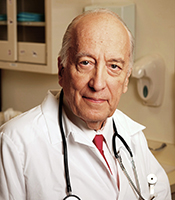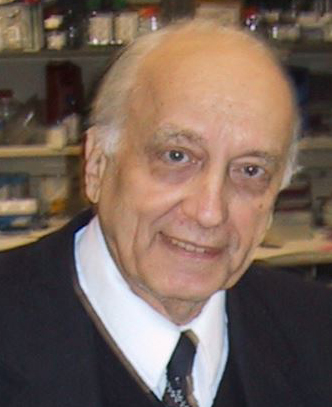Thomas A. Waldmann, M.D.

Brief Bio
Thomas A. Waldmann (1930–2021) was the Co-chief of the Lymphoid Malignancies Branch and Head of the Cytokine Immunology and Immunotherapy Section at the National Cancer Institute, National Institutes of Health. He was awarded the AAI-Steinman Award for Human Immunology Research Award in 2007.
Oral History - Full Interview
Interview Date: Thursday, December 9, 2015
Location: Bethesda, MD
Click here to see other interviews from the Oral History Project
Oral History - Transcript
Click here to download the transcript of this interview
AAI Service History
Joined: 1971
The Journal of Immunology
Associate Editor: 1977–1981
Editorial Board: 1982–1985
Other Service
AAI Representative, IUIS Nomenclature Committee: 1989–1992
Awards and Honors
Institutional/Biographical Links
- Center for Cancer Research, National Cancer Institute, profile
AAI In Memoriam

Thomas A. Waldmann
AAI extends condolences to the family, friends, and colleagues of Thomas A. Waldmann, M.D., AAI '71, a renowned immunologist at the National Institutes of Health (NIH) for more than six decades, who died on September 25.
Dr. Waldmann was a distinguished investigator and chief emeritus of the Lymphoid Malignancies Branch of the National Cancer Institute, NIH. He served as chief of the branch from 1971 (when it was known as the Metabolism Branch) until 2019.
Among his numerous career honors, Waldmann was the 2007 recipient of the AAI-Dana Foundation Award for Human Immunology (known today as the AAI-Steinman Award for Human Immunology Research) and presented the corresponding award lecture at the 2007 AAI annual meeting. He served as a past AAI representative to the International Union of Immunological Societies Nomenclature Committee and as an associate editor and editorial board member for The Journal of Immunology.
The following remembrance was authored by Waldmann’s NIH and AAI-member colleagues Warren J. Leonard, M.D. (AAI ‘86), NIH Distinguished Investigator, chief of the Laboratory of Molecular Immunology, and director of the Immunology Center, National Heart, Lung, and Blood Institute; and Jay A. Berzofsky, M.D., Ph.D. (AAI ’77), chief of the Vaccine Branch, Center for Cancer Research, National Cancer Institute. AAI gratefully acknowledges their submission.
* * * * *
Thomas Alexander Waldmann (1930–2021)
Thomas Alexander Waldmann, or “Tom” to his friends, was born in New York City on September 21, 1930, and died on September 25, 2021, just four days after his 91st birthday.
Within his remarkable 65-year-long active career at NIH, he saw the identification, cloning, and characterization of a huge range of major immunological cell surface and secreted molecules, and in several critical instances contributed to these advances, as well as to the development of immunotherapeutic approaches that could not have been dreamed of when he started at NIH in 1956. Tom’s scientific career evolved as did the field of immunology, and he was a scholar of great depth whose knowledge spanned the field and who helped to open new areas of immunological research. Tom’s major drive was to translate his basic discoveries to clinical cures for disease, and his own work was truly from bench to bedside and bedside to bench, serving as a role model for three generations of physician-scientists.
Tom attended the University of Chicago as an undergraduate and then graduated from Harvard Medical School in 1955. After an internship at the Massachusetts General Hospital, he arrived at NIH in 1956 as a clinical associate, working under Nat Berlin in the Metabolism Branch, National Cancer Institute. He had many opportunities to leave over the years for positions at major universities, but Tom never left and became branch chief in 1971, a position he held until 2019. Tom worked actively until just before his passing, combining basic science with the unique translational opportunities provided by the NIH Clinical Center. He was incredibly prolific, publishing more than 870 articles, including many landmark papers.
Tom’s initial research related to erythropoiesis, but he soon developed an interest in the metabolism of secreted proteins, including albumin and immunoglobulins, determining the plasma half-life of human immunoglobulin in vivo for the first time. Those studies linked his research to immunology, a field to which he was attracted based on the power of the then-recent polio vaccine and the idea of modulating the immune response to control a range of diseases.
His interest in immunoglobulin metabolism led him, with Warren Strober and R. Michael Blaese, to immunodeficiencies such as hypogammaglobulinemia and protein-losing enteropathies, of which one was named after Tom. Over time, he focused on adult T cell leukemia (ATL), a profound disease that is caused by the human retrovirus, HTLV-I, and which is associated with defective immune function; indeed, with Samuel Broder, Tom showed that ATL cells were a monoclonal population of suppressor T cells.
In an effort to develop an antibody to CD4 T cell activation markers, Takashi Uchiyama and Sam Broder in Tom’s laboratory developed monoclonal anti-Tac antibody, which turned out to be the first antibody to the human IL-2 receptor α chain. Tom took full advantage of this serendipity, characterizing normal activated lymphocytes as well as ATL cells, which express an overabundance of “Tac antigen,” thereby making them susceptible to anti-Tac. The antibody also facilitated the cloning of cDNAs encoding IL-2Rα by one of us (WJL) and Warner Greene, with Tom. Tom also developed anti-Tac into a humanized therapeutic antibody, Daclizumab, which he used to cure a subset of ATL patients, and this antibody was FDA-approved for the treatment of multiple sclerosis. Tom additionally collaborated with Ira Pastan to generate toxin-armed Daclizumab.
Moreover, Tom’s laboratory co-discovered IL-15—in his case as a molecule derived from an HTLV-I-transformed T cell line that he demonstrated shared with IL-2 the signaling components of the receptor (IL-2Rβ and the common γ chain) but that dramatically differs in its main actions. With Sigrid Dubois and Yutaka Tagaya in his lab, he demonstrated that IL-15 is presented primarily in trans by IL-15Ra on dendritic cells to the IL-2Rb and common g chains on T and NK cells, whereas IL-2 signals in cis, with IL-2Rα as well as the IL-2Rb and the common g chain together forming the high-affinity IL-2 receptor complex. Moreover, IL-15 was required for NK cell development and promoted CD8 memory T cells, but unlike IL-2, did not promote activation-induced cell death or induce the generation of T regulatory cells. Tom orchestrated the development of cGMP-grade IL-15 and performed the first in-human trials with IL-15 in the quest to develop its therapeutic potential for cancer.
Tom achieved scientific “greatness” and delivered more than 100 named lectures, was elected to the National Academy of Medicine, the National Academy of Sciences, and the American Academy of Arts and Sciences, and received many awards and honors, including the 2007 AAI-Dana Foundation Award for Human Immunology (known today as the AAI-Ralph Steinman Award for Human Immunology Research).
However, Tom was also an individual for whom family invariably came first, always reserving time for his wife Kathy, his three children, Richard, Robert, and Carol, and their spouses and children. He was a dear friend to many as well as a cherished mentor who trained future leaders in immunology. He was also an award-winning photographer who served as president of the NIH Camera Club and mentor to many aspiring photographers as well as immunologists.
Tom left a massive imprint on immunology and the many immunologists he mentored. With his passing, our field has lost one of its giants; he will be missed by many as a colleague, friend, mentor, and extraordinary physician-scientist.
* * * * * *
The Waldmann family invites donations in Dr. Waldmann’s memory to the International Medical Corps.
In addition to the small service and burial held in October, a more formal celebration of Dr. Waldmann’s life is planned for a future date.
For additional Waldmann tributes, see also:
View Waldmann’s 2015 interview as part of the AAI Oral History Project.